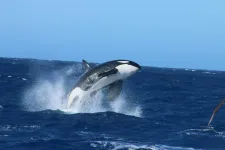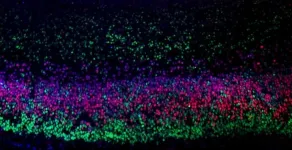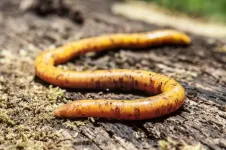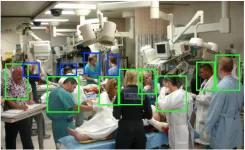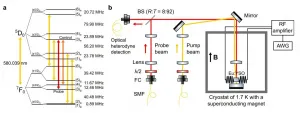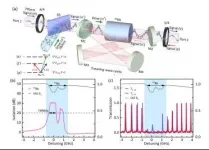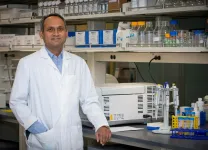(Press-News.org) DURHAM, N.C. - A potential new vaccine developed by members of the Duke Human Vaccine Institute has proven effective in protecting monkeys and mice from a variety of coronavirus infections -- including SARS-CoV-2 as well as the original SARS-CoV-1 and related bat coronaviruses that could potentially cause the next pandemic.
The new vaccine, called a pan-coronavirus vaccine, triggers neutralizing antibodies via a nanoparticle. The nanoparticle is composed of the coronavirus part that allows it to bind to the body's cell receptors and is formulated with a chemical booster called an adjuvant. Success in primates is highly relevant to humans.
The findings appear Monday, May 10, in the journal Nature.
"We began this work last spring with the understanding that, like all viruses, mutations would occur in the SARS-CoV-2 virus, which causes COVID-19," said senior author Barton F. Haynes, M.D., director of the Duke Human Vaccine Institute (DHVI). "The mRNA vaccines were already under development, so we were looking for ways to sustain their efficacy once those variants appeared.
"This approach not only provided protection against SARS-CoV-2, but the antibodies induced by the vaccine also neutralized variants of concern that originated in the United Kingdom, South Africa and Brazil," Haynes said. "And the induced antibodies reacted with quite a large panel of coronaviruses."
Haynes and colleagues, including lead author Kevin Saunders, Ph.D., director of research at DHVI, built on earlier studies involving SARS, the respiratory illness caused by a coronavirus called SARS-CoV-1. They found a person who had been infected with SARS developed antibodies capable of neutralizing multiple coronaviruses, suggesting that a pan-coronavirus might be possible.
The Achilles heel for the coronaviruses is their receptor-binding domain, located on the spike that links the viruses to receptors in human cells. While this binding site enables it to enter the body and cause infection, it can also be targeted by antibodies.
The research team identified one particular receptor-binding domain site that is present on SARS-CoV-2, its circulating variants and SARS-related bat viruses that makes them highly vulnerable to cross-neutralizing antibodies.
The team then designed a nanoparticle displaying this vulnerable spot. The nanoparticle is combined with a small molecule adjuvant -- specifically, the toll-like receptor 7 and 8 agonist called 3M-052, formulated with Alum, which was developed by 3M and the Infectious Disease Research Institute. The adjuvant boosts the body's immune response.
In tests of its effect on monkeys, the nanoparticle vaccine blocked COVID-19 infection by 100%. The new vaccine also elicited significantly higher neutralizing levels in the animals than current vaccine platforms or natural infection in humans.
"Basically what we've done is take multiple copies of a small part of the coronavirus to make the body's immune system respond to it in a heightened way," Saunders said. "We found that not only did that increase the body's ability to inhibit the virus from causing infection, but it also targets this cross-reactive site of vulnerability on the spike protein more frequently. We think that's why this vaccine is effective against SARS-CoV-1, SARS-CoV-2 and at least four of its common variants, plus additional animal coronaviruses."
"There have been three coronavirus epidemics in the past 20 years, so there is a need to develop effective vaccines that can target these pathogens prior to the next pandemic," Haynes said. "This work represents a platform that could prevent, rapidly temper, or extinguish a pandemic."
INFORMATION:
In addition to Haynes and Saunders, study authors include Esther Lee, Robert Parks1,5, David R. Martinez, Dapeng, Haiyan Chen, Robert J. Edwards, Sophie Gobeil, Maggie Barr, Katayoun Mansour, S. Munir Alam, Laura L. Sutherland, Fangping Cai, Aja M. Sanzone, Madison Berry, Kartik Manne, Kevin W. Bock, Mahnaz Minai, Bianca M. Nagata, Anyway B. Kapingidza, Mihai Azoitei, Longping V. Tse, Trevor D. Scobey, Rachel L. Spreng, R. Wes Rountree, C. Todd DeMarco, Thomas N. Denny, Christopher W. Woods, Elizabeth W. Petzold, Thomas H. Oguin III, Gregory D. Sempowski, Matthew Gagne, Daniel C. Douek, Mark A. Tomai, Christopher B. Fox, Robert Seder, Kevin Wiehe, Drew Weissman, Norbert Pardi, Hana Golding, Surender Khurana, Priyamvada Acharya, Hanne Andersen, Mark G. Lewis, Ian N. Moore, David C. Montefiori and Ralph S. Baric.
The study received funding from the State of North Carolina with funds from the federal CARES Act; the National Institutes of Health (AI142596, R01AI157155 U54 CA260543, F32 AI152296, T32 AI007151); the North Carolina Policy Collaboratory at the University of North Carolina at Chapel Hill with funding from the North Carolina Coronavirus Relief Fund; and a Burroughs Wellcome Fund Postdoctoral Enrichment Program Award.
A Flinders University researcher has finally fathomed why large numbers of killer whales gather at a single main location off the Western Australian southern coastline every summer.
In a new paper published in Deep Sea Research, physical oceanographer Associate Professor Jochen Kampf describes the conditions which have produced this ecological natural wonder of orcas migrating to the continental slope near Bremer Bay in the western Great Australian Bight from late austral spring to early autumn (January-April).
"The aggregation is connected to the local marine food web that follows from the upwelling of benthic particulate organic matter (POM) ...
A novel approach to immunotherapy design could pave the way for new treatments for people with an aggressive form of brain cancer called glioblastoma.
Using specifically designed receptors, researchers were able to completely clear brain cancer tumours in preclinical models, using chimeric antigen receptor (CAR) T cell therapy.
Published today in Clinical & Translational Immunology and led by Associate Professor Misty Jenkins, the research is a crucial step towards developing new immunotherapy treatments for this devastating illness.
More than 1800 Australians are diagnosed with brain cancer every year. ...
A new micro-light-emitting diode (micro-LED) developed at KAUST can efficiently emit pure red light and may help in the quest to develop full-color displays based on just a single semiconductor.
Micro-LEDs are a promising technology for the next generation of displays. They have the advantage of being energy efficient and very small. But each LED can only emit light over a narrow range of colors. A clever solution is to create devices that combine many different LEDs, each emitting a different color. Full-color micro-displays can be created by combining red, green and blue (RGB) micro-LEDs. Now, a KAUST team of Zhe Zhuang, Daisuke Iida and Kazuhiro Ohkawa have worked to develop ...
SAN FRANCISCO, CA (May 10, 2021) -- The Gulf of Guinea islands harbor an abundance of species found nowhere else on Earth. But for over 100 years, scientists have wondered whether or not a population of limbless, burrowing amphibians--known as caecilians--found on one of the islands is a single or multiple species. Now, a team of researchers from the California Academy of Sciences and the Smithsonian National Museum of Natural History has contributed the strongest evidence to date that there is not one, but two different species of caecilians on São Tomé ...
Computer scientists at the University of California San Diego have developed a more accurate navigation system that will allow robots to better negotiate busy clinical environments in general and emergency departments more specifically. The researchers have also developed a dataset of open source videos to help train robotic navigation systems in the future.
The team, led by Professor Laurel Riek and Ph.D. student Angelique Taylor, detail their findings in a paper for the International Conference on Robotics and Automation taking place May 30 to June 5 in Xi'an, China.
The project stemmed from conversations with clinicians over several years. The consensus was that robots would best help physicians, nurses and staff ...
An international team led by researchers from the Xinjiang Institute of Ecology and Geography (XIEG) of the Chinese Academy of Sciences and the University of Geneva has found that flash floods may triple across the Earth's "Third Pole" in response to ongoing climate change.
Their findings were published in Nature Climate Change on May 6.
The Hindu Kush-Himalaya, Tibetan Plateau and surrounding mountain ranges are widely known as the "Third Pole" of the Earth. It contains the largest number of glaciers outside the polar regions.
Due to global warming, the widespread and accelerated melting of glaciers over ...
Remote quantum distribution on the ground is limited because of the loss of photon in optical fibers. One solution for remote quantum communication lies in quantum memories: photons are stored in the long-lived quantum memory (quantum flash drive) and then quantum information is transmitted by the transportation of the quantum memory. Given the speed of aircrafts and high-speed trains, it is critical to increase the storage time of the quantum memories to the order of hours.
In a new study published in Nature Communications, a research team led by Prof. LI Chuanfeng and Prof. ZHOU Zongquan from University of Science and Technology of China (USTC) extended the storage time of the optical memories to over one hour. It broke the record of one minute achieved by German researchers in 2013, ...
Chinese researchers achieved 51.5dB nonreciprocal isolation in the atomic ensemble, which is the highest isolation ratio in the non-magnetic nonreciprocal field. They discussed the quantum noise problem in nonreciprocal devices for the first time.
The result was published on Nature Communications on April 22, 2021.
Nonreciprocity is an important basic concept in the optical field. The isolators and circulators derived from it are all indispensable components in the optical path. Faraday isolator based on circular birefringence of magneto-optical effect is widely used because of its easy construction, high isolation and low loss.
However, in the integrated optical path, the traditional faraday isolator is subject to various limitations. ...
COLUMBUS, Ohio - Watching meaningful films - those that we find moving and poignant - can make us feel more prepared to deal with life's challenges and want to be a better person, a new study found.
The findings point to one reason why people may choose to see movies that make them sad as well as happy and that may explore difficult subjects that aren't always uplifting.
Researchers found that when people recalled watching meaningful films like The Shawshank Redemption and Up, they reported a variety of positive reactions, such as being better able to accept the human condition and make sense of problems in life.
Those positive experiences were less likely to be reported when people thought about watching Hollywood fare like The Big Lebowski or Catch Me ...
TAMPA, Fla. (May 10, 2021) -- Blocking the fat-busting enzyme lipoxygenase with a synthetic inhibitor throws the immune system's innate inflammatory response out of whack, compromising cardiac repair during acute heart failure, USF Health researchers found.
Their new preclinical study was published April 13 in Biomedicine & Pharmacotherapy.
Acute heart failure - triggered by a heart attack, severely irregular heartbeats, or other causes -- occurs suddenly when the heart cannot pump enough blood to meet the body's demands.
Following a heart attack or any cardiac injury, signals to immune cells called leukocytes ...
